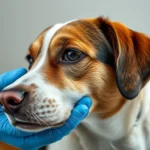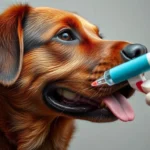
Introduction
Pyoderma is a term used to describe a bacterial skin infection in dogs that can manifest in various forms and severities. Understanding this condition is crucial for dog owners, as it not only affects a pet’s skin health but can also indicate underlying health issues. Pyoderma in dogs is relatively common, and recognizing it early can make a significant difference in treatment outcomes.
The prevalence of pyoderma varies among different breeds, with certain breeds such as English Bulldogs, Boxers, and Cocker Spaniels being more susceptible. Awareness of this condition helps pet owners take proactive steps to maintain their dog’s health.
Understanding Pyoderma
What Causes Pyoderma?
Bacterial Infections
The most common cause of pyoderma in dogs is bacterial infections, primarily involving the bacterium Staphylococcus pseudintermedius. This bacterium is typically found on the skin of healthy dogs but can overgrow and cause infections under certain conditions.
Underlying Conditions
In many instances, pyoderma is secondary to other underlying health issues. These can include:
- Allergies (food or environmental)
- Parasites (e.g., fleas, mites)
- Skin conditions (e.g., dermatitis, hot spots)
Types of Pyoderma
Superficial Pyoderma
This type affects only the outer layer of the skin, leading to pustules and crusts. Symptoms often include localized redness and itching. Superficial pyoderma is usually easier to treat and may resolve with topical treatments.
Deep Pyoderma
In contrast, deep pyoderma involves deeper layers of the skin and can be more severe, often presenting with painful lumps and significant swelling. This type may require systemic antibiotics and more extensive veterinary care.
Localized vs. Generalized
- Localized Pyoderma: Found in one area of the body, often easier to manage.
- Generalized Pyoderma: Widespread across the body, indicating a more severe underlying issue that may require comprehensive treatment.
Symptoms of Pyoderma
Common Signs to Look For
When examining your dog, keep an eye out for the following signs of pyoderma:
- Skin Lesions: Look for red, inflamed, or crusty patches on the skin.
- Itching and Discomfort: Your dog may scratch, lick, or bite at affected areas more frequently.
Advanced Symptoms
As pyoderma progresses, you may notice more severe symptoms, including:
- Swelling and Redness: The affected areas may appear swollen or overly red.
- Foul Odor: A strong, unpleasant smell emanating from the skin can indicate a bacterial infection.
- Hair Loss: Patches of hair may fall out around the lesions.
- Secondary Infections: If untreated, pyoderma can lead to more serious complications.
Diagnosis of Pyoderma
Veterinary Examination
A visit to the veterinarian is essential for diagnosing pyoderma. During a physical examination, the vet will assess the affected areas and may ask about your dog’s medical history, diet, and environment.
Diagnostic Tests
To confirm a diagnosis of pyoderma, several tests may be performed, including:
- Skin Scraping: This involves taking a sample from the affected area to check for parasites or fungal infections.
- Culture and Sensitivity Testing: This test helps identify the specific bacteria causing the infection and determines the most effective antibiotic for treatment.
- Allergy Testing: Since allergies can trigger pyoderma, your vet may recommend tests to identify potential allergens.
Treatment Options
Veterinary Prescribed Treatments
Antibiotics
For bacterial infections, your veterinarian may prescribe antibiotics, which can be administered orally or topically. The duration of treatment can vary depending on the severity of the infection, typically lasting from 3 weeks to several months.
Topical Treatments
Shampoos and ointments specifically designed for treating pyoderma can be highly effective. These treatments often contain antibacterial or anti-inflammatory ingredients to soothe the skin and promote healing.
Home Care and Management
Regular Grooming
Maintaining your dog’s coat through regular grooming helps prevent matting and keeps the skin healthy. Use dog-specific grooming tools and consider shampoos formulated for sensitive skin.
Dietary Considerations
Nutrition plays a vital role in skin health. Ensure your dog is on a balanced diet rich in omega fatty acids, which can support skin integrity and reduce inflammation.
Long-term Management
Preventative Measures
Regular check-ups with your veterinarian are essential for early detection of skin issues. Keeping your dog’s living environment clean and free from allergens can also help prevent pyoderma outbreaks.
Prevention of Pyoderma
Regular Health Check-ups
Routine veterinary visits are crucial for maintaining your dog’s overall health and catching potential issues early. These check-ups can lead to early intervention, reducing the risk of severe pyoderma.
Environmental Management
Minimizing exposure to allergens can significantly impact your dog’s skin health. Consider the following tips:
- Use hypoallergenic bedding.
- Regularly clean your home to remove dust and pet dander.
- Avoid using harsh cleaning products around your dog.
Grooming and Hygiene Practices
Maintaining a regular grooming routine is essential. Recommended practices include:
- Routine Bathing: Bathe your dog with a medicated shampoo if recommended by your vet, but avoid over-bathing, which can strip natural oils.
- Brushing: Brush your dog’s coat several times a week to remove loose hair and prevent matting.
When to Seek Veterinary Help
Signs That Require Immediate Attention
If you notice any worsening symptoms, such as increased swelling, severe itching, or a rapid spread of lesions, seek veterinary assistance promptly. Early intervention can prevent complications.
Importance of Professional Guidance
While home remedies may seem appealing, they can often do more harm than good. Always consult with a veterinarian for proper diagnosis and treatment options for pyoderma.
Frequently Asked Questions (FAQs)
Can Pyoderma Be Cured?
Pyoderma can be effectively treated, but the prognosis depends on underlying causes and the severity of the infection. With proper veterinary care and management, many dogs recover fully.
How is Pyoderma Different from Other Skin Conditions?
Unlike other skin conditions that may arise from environmental factors or allergies, pyoderma is primarily a bacterial infection. It often requires specific treatments to resolve the bacterial overgrowth, unlike conditions that may be managed solely through environmental or dietary changes.
Is Pyoderma Contagious?
No, pyoderma is not contagious. It occurs due to factors specific to the individual dog’s health, such as skin integrity, immune system status, and underlying conditions.
Conclusion
Understanding pyoderma in dogs is essential for all pet owners. Recognizing the signs, seeking timely veterinary care, and implementing preventive measures can lead to successful management of this condition. With the right approach, pet owners can ensure their furry friends maintain healthy skin and a happy life. Always remember, consulting your veterinarian for any concerns regarding your dog’s skin health is the best course of action.









